Specific Needs in Health and Social Care: Legislation & Services
VerifiedAdded on 2023/06/12
|14
|4038
|311
Essay
AI Summary
This essay provides a comprehensive analysis of specific needs within the health and social care sector in the UK. It begins by defining key concepts such as health, disability, illness, and behavior, and examines how perceptions of these needs have evolved over time. The essay further explores the impact of legislation, social policy, society, and culture on the provision of services to individuals with specific needs. It assesses the care needs of these individuals and explains the current systems in place to support them, evaluating the effectiveness of available services and intervention strategies, including Community Based Rehabilitation (CBR) and intermediate care. The essay concludes by discussing the potential impact of emerging developments in support for individuals with specific needs, highlighting improvements in community inclusion, education, training, and vocational opportunities.
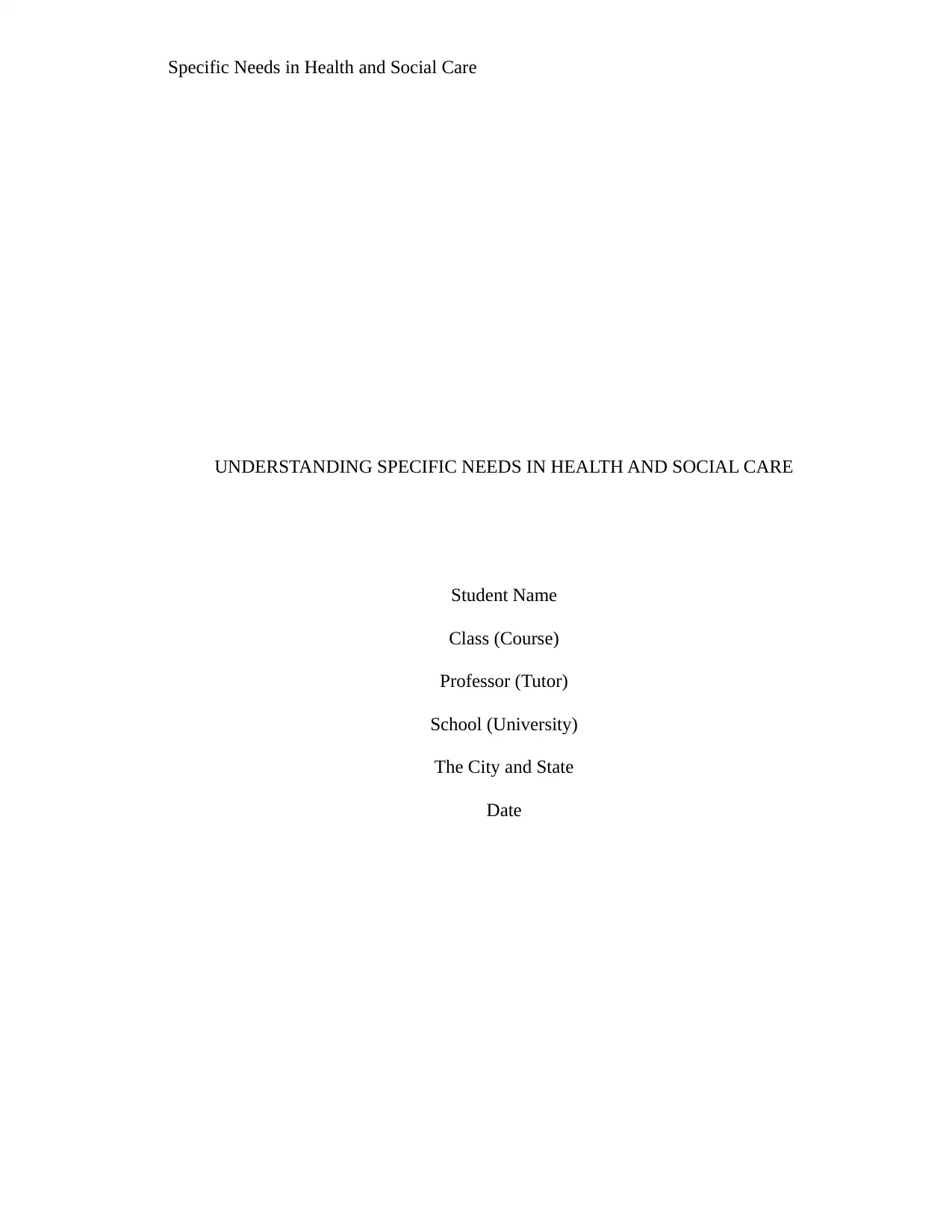
Specific Needs in Health and Social Care
UNDERSTANDING SPECIFIC NEEDS IN HEALTH AND SOCIAL CARE
Student Name
Class (Course)
Professor (Tutor)
School (University)
The City and State
Date
UNDERSTANDING SPECIFIC NEEDS IN HEALTH AND SOCIAL CARE
Student Name
Class (Course)
Professor (Tutor)
School (University)
The City and State
Date
Paraphrase This Document
Need a fresh take? Get an instant paraphrase of this document with our AI Paraphraser
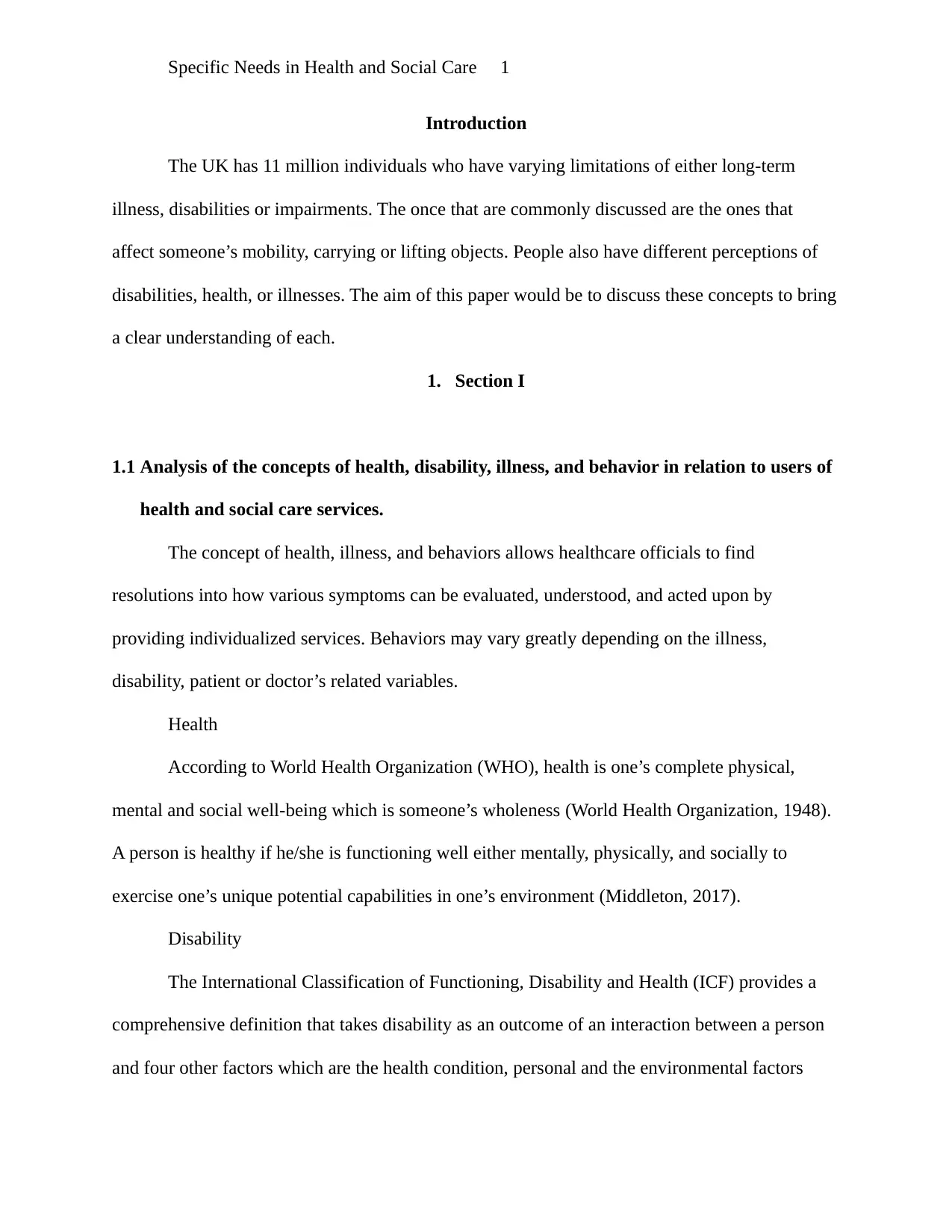
Specific Needs in Health and Social Care 1
Introduction
The UK has 11 million individuals who have varying limitations of either long-term
illness, disabilities or impairments. The once that are commonly discussed are the ones that
affect someone’s mobility, carrying or lifting objects. People also have different perceptions of
disabilities, health, or illnesses. The aim of this paper would be to discuss these concepts to bring
a clear understanding of each.
1. Section I
1.1 Analysis of the concepts of health, disability, illness, and behavior in relation to users of
health and social care services.
The concept of health, illness, and behaviors allows healthcare officials to find
resolutions into how various symptoms can be evaluated, understood, and acted upon by
providing individualized services. Behaviors may vary greatly depending on the illness,
disability, patient or doctor’s related variables.
Health
According to World Health Organization (WHO), health is one’s complete physical,
mental and social well-being which is someone’s wholeness (World Health Organization, 1948).
A person is healthy if he/she is functioning well either mentally, physically, and socially to
exercise one’s unique potential capabilities in one’s environment (Middleton, 2017).
Disability
The International Classification of Functioning, Disability and Health (ICF) provides a
comprehensive definition that takes disability as an outcome of an interaction between a person
and four other factors which are the health condition, personal and the environmental factors
Introduction
The UK has 11 million individuals who have varying limitations of either long-term
illness, disabilities or impairments. The once that are commonly discussed are the ones that
affect someone’s mobility, carrying or lifting objects. People also have different perceptions of
disabilities, health, or illnesses. The aim of this paper would be to discuss these concepts to bring
a clear understanding of each.
1. Section I
1.1 Analysis of the concepts of health, disability, illness, and behavior in relation to users of
health and social care services.
The concept of health, illness, and behaviors allows healthcare officials to find
resolutions into how various symptoms can be evaluated, understood, and acted upon by
providing individualized services. Behaviors may vary greatly depending on the illness,
disability, patient or doctor’s related variables.
Health
According to World Health Organization (WHO), health is one’s complete physical,
mental and social well-being which is someone’s wholeness (World Health Organization, 1948).
A person is healthy if he/she is functioning well either mentally, physically, and socially to
exercise one’s unique potential capabilities in one’s environment (Middleton, 2017).
Disability
The International Classification of Functioning, Disability and Health (ICF) provides a
comprehensive definition that takes disability as an outcome of an interaction between a person
and four other factors which are the health condition, personal and the environmental factors
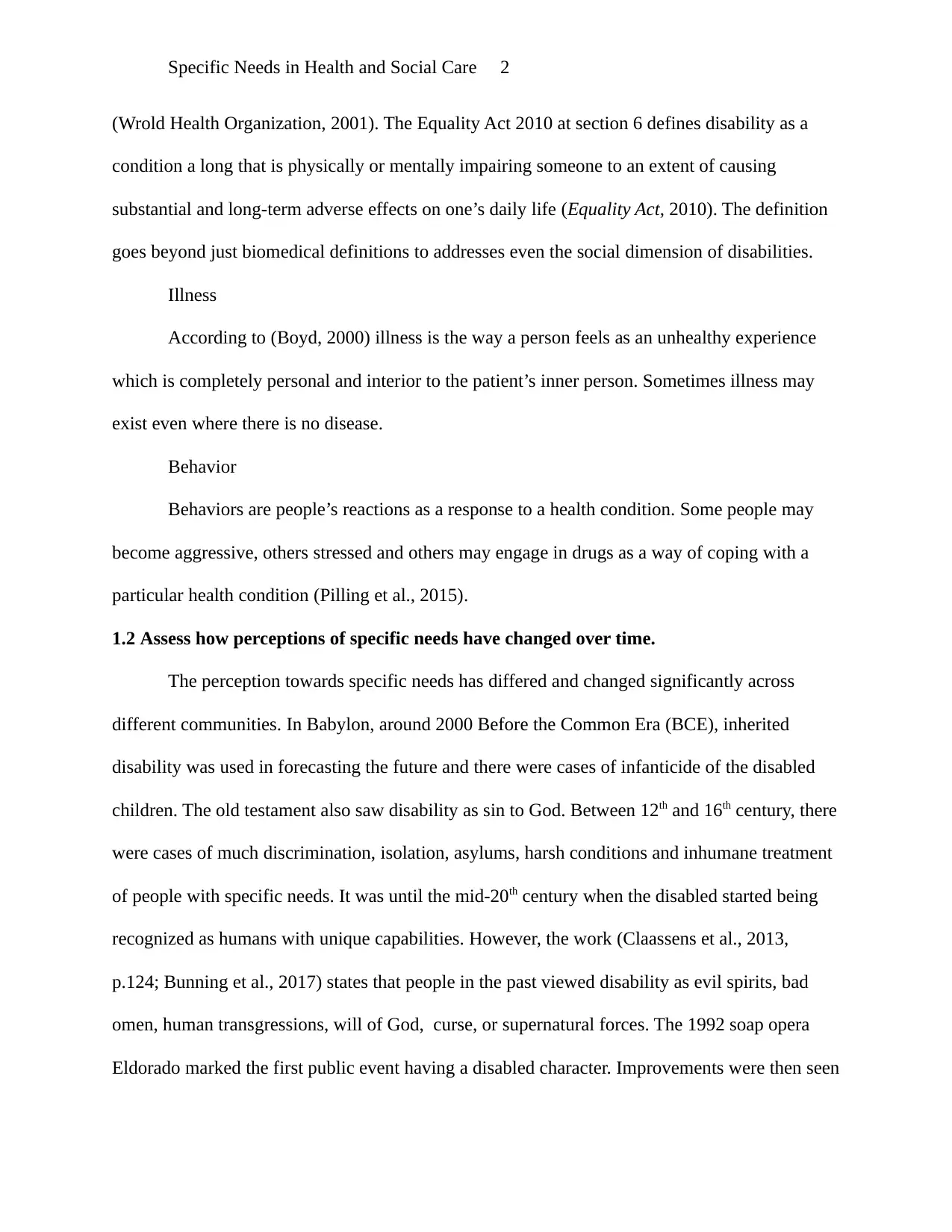
Specific Needs in Health and Social Care 2
(Wrold Health Organization, 2001). The Equality Act 2010 at section 6 defines disability as a
condition a long that is physically or mentally impairing someone to an extent of causing
substantial and long-term adverse effects on one’s daily life (Equality Act, 2010). The definition
goes beyond just biomedical definitions to addresses even the social dimension of disabilities.
Illness
According to (Boyd, 2000) illness is the way a person feels as an unhealthy experience
which is completely personal and interior to the patient’s inner person. Sometimes illness may
exist even where there is no disease.
Behavior
Behaviors are people’s reactions as a response to a health condition. Some people may
become aggressive, others stressed and others may engage in drugs as a way of coping with a
particular health condition (Pilling et al., 2015).
1.2 Assess how perceptions of specific needs have changed over time.
The perception towards specific needs has differed and changed significantly across
different communities. In Babylon, around 2000 Before the Common Era (BCE), inherited
disability was used in forecasting the future and there were cases of infanticide of the disabled
children. The old testament also saw disability as sin to God. Between 12th and 16th century, there
were cases of much discrimination, isolation, asylums, harsh conditions and inhumane treatment
of people with specific needs. It was until the mid-20th century when the disabled started being
recognized as humans with unique capabilities. However, the work (Claassens et al., 2013,
p.124; Bunning et al., 2017) states that people in the past viewed disability as evil spirits, bad
omen, human transgressions, will of God, curse, or supernatural forces. The 1992 soap opera
Eldorado marked the first public event having a disabled character. Improvements were then seen
(Wrold Health Organization, 2001). The Equality Act 2010 at section 6 defines disability as a
condition a long that is physically or mentally impairing someone to an extent of causing
substantial and long-term adverse effects on one’s daily life (Equality Act, 2010). The definition
goes beyond just biomedical definitions to addresses even the social dimension of disabilities.
Illness
According to (Boyd, 2000) illness is the way a person feels as an unhealthy experience
which is completely personal and interior to the patient’s inner person. Sometimes illness may
exist even where there is no disease.
Behavior
Behaviors are people’s reactions as a response to a health condition. Some people may
become aggressive, others stressed and others may engage in drugs as a way of coping with a
particular health condition (Pilling et al., 2015).
1.2 Assess how perceptions of specific needs have changed over time.
The perception towards specific needs has differed and changed significantly across
different communities. In Babylon, around 2000 Before the Common Era (BCE), inherited
disability was used in forecasting the future and there were cases of infanticide of the disabled
children. The old testament also saw disability as sin to God. Between 12th and 16th century, there
were cases of much discrimination, isolation, asylums, harsh conditions and inhumane treatment
of people with specific needs. It was until the mid-20th century when the disabled started being
recognized as humans with unique capabilities. However, the work (Claassens et al., 2013,
p.124; Bunning et al., 2017) states that people in the past viewed disability as evil spirits, bad
omen, human transgressions, will of God, curse, or supernatural forces. The 1992 soap opera
Eldorado marked the first public event having a disabled character. Improvements were then seen
⊘ This is a preview!⊘
Do you want full access?
Subscribe today to unlock all pages.

Trusted by 1+ million students worldwide

Specific Needs in Health and Social Care 3
in 2012 The Olympic Games and Paralympic Games where the disabled persons were shown
winning elite athletic medals. In addition, the UK has also enacted taken various step in
empowering the people with special needs i.e the enactment and enforcement legislation such as
the Equality Act, and the enforcement of the Human Right Act to cater for the disabled.
1.3 Analyse the impacts of legislation, social policy, society and culture on the ways in
which services are made available to individuals with specific needs.
Legislations are avenues for social justice in the delivery of services to people specific
needs. They outline the rights which are the first determinants of well-being. For instance, the
Human Rights Act makes discrimination unlawful on people with special needs (Human Rights
Act, 1998). Legislations also create legal rules, duties, and powers of the officers providing the
services. Lastly, legislations regulate the conducts and decisions regarding service delivery. For
instance, the equality Act requires equality in the distribution of resources and services (Equality
Act, 2010).
Social policies help in addressing the social determinants of health (SDH) in people with
specific needs (Donkin et al., 2017). Policies provide definite guidelines for the delivery of
services by relevant departments and legislation. Policies inform social workers on
mainstreaming and integrating development practices to the people. Policies act like tools for
implementation of legislation to achieve socio-economic development, inclusion, and protection
of the social welfare of people with specific needs. A culture of society may determine the
behavior of people with specific needs. Cultural factors have the power of influencing the well-
being of people by influencing attitudes, parameters of coping, health intervention, rehabilitation
etc (Sousa and Almeida, 2016). For instance, culture may influence how a society perceives
in 2012 The Olympic Games and Paralympic Games where the disabled persons were shown
winning elite athletic medals. In addition, the UK has also enacted taken various step in
empowering the people with special needs i.e the enactment and enforcement legislation such as
the Equality Act, and the enforcement of the Human Right Act to cater for the disabled.
1.3 Analyse the impacts of legislation, social policy, society and culture on the ways in
which services are made available to individuals with specific needs.
Legislations are avenues for social justice in the delivery of services to people specific
needs. They outline the rights which are the first determinants of well-being. For instance, the
Human Rights Act makes discrimination unlawful on people with special needs (Human Rights
Act, 1998). Legislations also create legal rules, duties, and powers of the officers providing the
services. Lastly, legislations regulate the conducts and decisions regarding service delivery. For
instance, the equality Act requires equality in the distribution of resources and services (Equality
Act, 2010).
Social policies help in addressing the social determinants of health (SDH) in people with
specific needs (Donkin et al., 2017). Policies provide definite guidelines for the delivery of
services by relevant departments and legislation. Policies inform social workers on
mainstreaming and integrating development practices to the people. Policies act like tools for
implementation of legislation to achieve socio-economic development, inclusion, and protection
of the social welfare of people with specific needs. A culture of society may determine the
behavior of people with specific needs. Cultural factors have the power of influencing the well-
being of people by influencing attitudes, parameters of coping, health intervention, rehabilitation
etc (Sousa and Almeida, 2016). For instance, culture may influence how a society perceives
Paraphrase This Document
Need a fresh take? Get an instant paraphrase of this document with our AI Paraphraser

Specific Needs in Health and Social Care 4
social help. A certain community that feels that a particular service is not culturally inappropriate
may avoid the service.
2. Section II
2.1 Analyze the care needs of individuals with specific needs.
According to (Spicker, 2014), the concept of need involves mainly the problems people
undergo. The work of (Faull et al., 2008, p.44) then explains that need incorporates a wider scope
of social and environmental determinants of health which is a broad concept going beyond
medical approaches to include other factors that influence health and well-being. The work of
(Bradshaw, 2013, pp.1–10) classifies needs into normative needs which are what a professional
thinks people want, comparative needs which arise out of comparisons of people or situations
and finding what one side has what makes them better than the other side, felt needs are those a
person feels that he wants and express needs are that person would demand. The (GOV. UK.
Department of Health and Social Care, 2012) defines social care needs as those aimed to provide
assistance with daily living activities, social interaction, maintaining independence to enable a
people’s full participation in the society, protect them during vulnerable situations, help them in
managing complex situations and relationships and helping them access a care home.
2.2 Explain current systems for supporting individuals with specific needs.
The work, health, and disability green paper state that the UK government is resolute in
building a country that is suitable for everyone (GOV. UK. Department of Health and Social
Care, 2017). In this effort, the government has various systems such as providing people with
special needs with benefits and financial assistance. i.e, disability living allowances, the
employment and support allowances etc. The government also recognizes the efforts of the
carers by providing them with Carer's allowances. The government also provides people with
social help. A certain community that feels that a particular service is not culturally inappropriate
may avoid the service.
2. Section II
2.1 Analyze the care needs of individuals with specific needs.
According to (Spicker, 2014), the concept of need involves mainly the problems people
undergo. The work of (Faull et al., 2008, p.44) then explains that need incorporates a wider scope
of social and environmental determinants of health which is a broad concept going beyond
medical approaches to include other factors that influence health and well-being. The work of
(Bradshaw, 2013, pp.1–10) classifies needs into normative needs which are what a professional
thinks people want, comparative needs which arise out of comparisons of people or situations
and finding what one side has what makes them better than the other side, felt needs are those a
person feels that he wants and express needs are that person would demand. The (GOV. UK.
Department of Health and Social Care, 2012) defines social care needs as those aimed to provide
assistance with daily living activities, social interaction, maintaining independence to enable a
people’s full participation in the society, protect them during vulnerable situations, help them in
managing complex situations and relationships and helping them access a care home.
2.2 Explain current systems for supporting individuals with specific needs.
The work, health, and disability green paper state that the UK government is resolute in
building a country that is suitable for everyone (GOV. UK. Department of Health and Social
Care, 2017). In this effort, the government has various systems such as providing people with
special needs with benefits and financial assistance. i.e, disability living allowances, the
employment and support allowances etc. The government also recognizes the efforts of the
carers by providing them with Carer's allowances. The government also provides people with

Specific Needs in Health and Social Care 5
special needs with necessary equipment. For instance, the blue badge, bus pass, garden upkeep
for elderly, home equipment etc. The Equality Act also provides for inclusion, the disability
rights, rights against discrimination, and defines for when mental health conditions could become
a disability. The government also provides education for children with special needs (Department
for Education, 2011). Also, the governments require inclusion and creation of work for the
disabled which also requires reasonable adjustments at work to allow access of the people with
special needs.
2.3 Evaluate the services available in a chosen locality for individuals with specific needs.
There are various local services accessible in the UK for people with specific needs but
these services vary according to one’s needs. The following are the different services;
a. Equipment services: These are simple tools and devices that are meant for helping
someone exercise some independence despite the limitations of the disability. i.e
getting to the toilets, bed, etc.
b. Personal help at home: This is getting someone to help in home activities such as
dressing., laundry, food preparation etc.
c. The money advice: Provide career development or personal assistant guide.
d. Nursing home: Those with problems living at home may prefer to relocate to
nursing homes.
e. The residential care is available where staying at home becomes an non-practical
option.
f. Day centers: These provides meals or opportunities for socializing in activities.
special needs with necessary equipment. For instance, the blue badge, bus pass, garden upkeep
for elderly, home equipment etc. The Equality Act also provides for inclusion, the disability
rights, rights against discrimination, and defines for when mental health conditions could become
a disability. The government also provides education for children with special needs (Department
for Education, 2011). Also, the governments require inclusion and creation of work for the
disabled which also requires reasonable adjustments at work to allow access of the people with
special needs.
2.3 Evaluate the services available in a chosen locality for individuals with specific needs.
There are various local services accessible in the UK for people with specific needs but
these services vary according to one’s needs. The following are the different services;
a. Equipment services: These are simple tools and devices that are meant for helping
someone exercise some independence despite the limitations of the disability. i.e
getting to the toilets, bed, etc.
b. Personal help at home: This is getting someone to help in home activities such as
dressing., laundry, food preparation etc.
c. The money advice: Provide career development or personal assistant guide.
d. Nursing home: Those with problems living at home may prefer to relocate to
nursing homes.
e. The residential care is available where staying at home becomes an non-practical
option.
f. Day centers: These provides meals or opportunities for socializing in activities.
⊘ This is a preview!⊘
Do you want full access?
Subscribe today to unlock all pages.

Trusted by 1+ million students worldwide
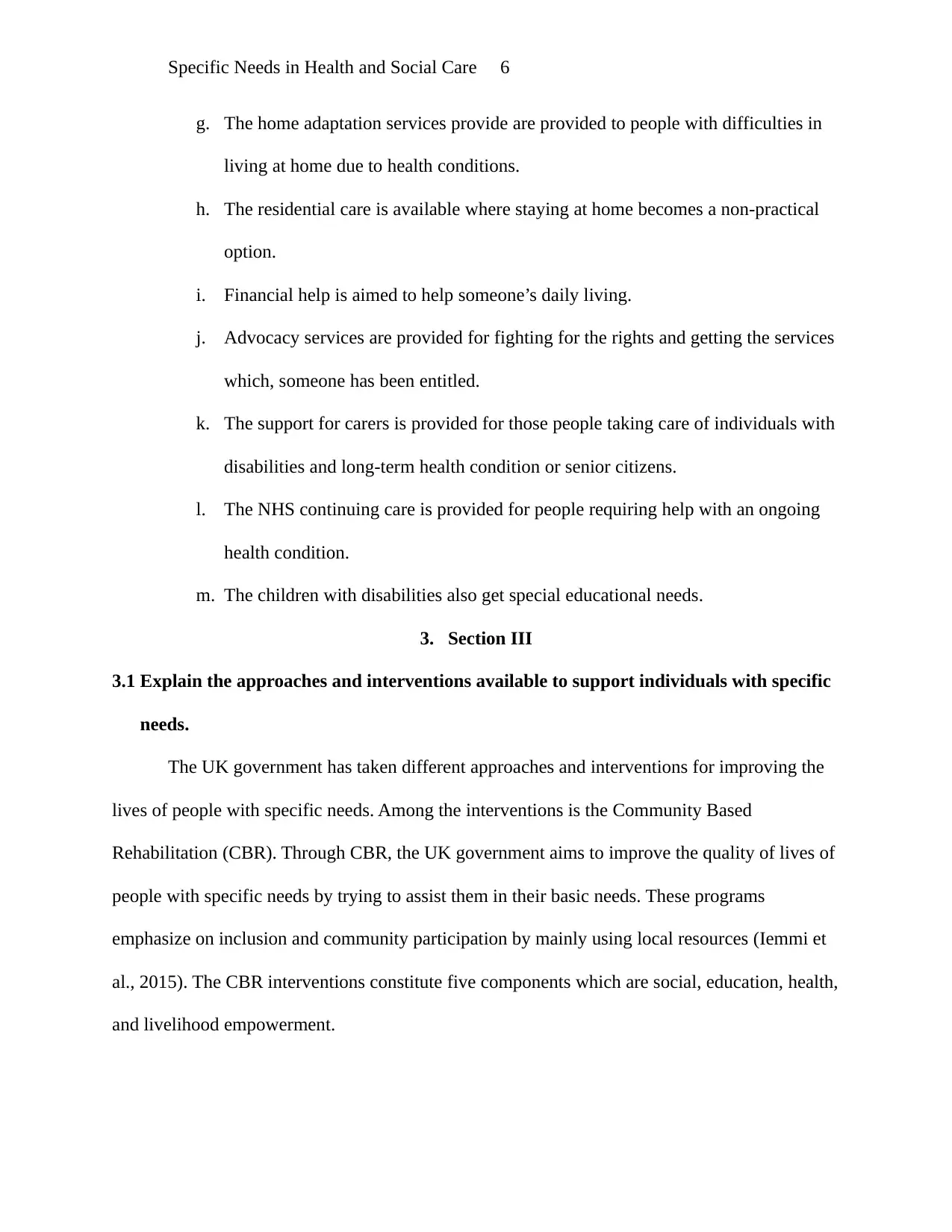
Specific Needs in Health and Social Care 6
g. The home adaptation services provide are provided to people with difficulties in
living at home due to health conditions.
h. The residential care is available where staying at home becomes a non-practical
option.
i. Financial help is aimed to help someone’s daily living.
j. Advocacy services are provided for fighting for the rights and getting the services
which, someone has been entitled.
k. The support for carers is provided for those people taking care of individuals with
disabilities and long-term health condition or senior citizens.
l. The NHS continuing care is provided for people requiring help with an ongoing
health condition.
m. The children with disabilities also get special educational needs.
3. Section III
3.1 Explain the approaches and interventions available to support individuals with specific
needs.
The UK government has taken different approaches and interventions for improving the
lives of people with specific needs. Among the interventions is the Community Based
Rehabilitation (CBR). Through CBR, the UK government aims to improve the quality of lives of
people with specific needs by trying to assist them in their basic needs. These programs
emphasize on inclusion and community participation by mainly using local resources (Iemmi et
al., 2015). The CBR interventions constitute five components which are social, education, health,
and livelihood empowerment.
g. The home adaptation services provide are provided to people with difficulties in
living at home due to health conditions.
h. The residential care is available where staying at home becomes a non-practical
option.
i. Financial help is aimed to help someone’s daily living.
j. Advocacy services are provided for fighting for the rights and getting the services
which, someone has been entitled.
k. The support for carers is provided for those people taking care of individuals with
disabilities and long-term health condition or senior citizens.
l. The NHS continuing care is provided for people requiring help with an ongoing
health condition.
m. The children with disabilities also get special educational needs.
3. Section III
3.1 Explain the approaches and interventions available to support individuals with specific
needs.
The UK government has taken different approaches and interventions for improving the
lives of people with specific needs. Among the interventions is the Community Based
Rehabilitation (CBR). Through CBR, the UK government aims to improve the quality of lives of
people with specific needs by trying to assist them in their basic needs. These programs
emphasize on inclusion and community participation by mainly using local resources (Iemmi et
al., 2015). The CBR interventions constitute five components which are social, education, health,
and livelihood empowerment.
Paraphrase This Document
Need a fresh take? Get an instant paraphrase of this document with our AI Paraphraser

Specific Needs in Health and Social Care 7
Another approach is the intermediate care. The IC is described as a care falling between
primary and secondary care (Woodford and George, 2010). The IC is usually a short time
service that focuses on helping someone to regain his or her independence. The approach is
delivered by professionals who with someone to achieve what someone hopes to do.
3.2 Evaluate the effectiveness of intervention strategies for an individual with specific
needs.
The efficacy of CBR has been noted to improve the lives of people living with
disabilities. Evidence-based guidelines have shown that CBR accompanied with medication has
been effective in the reduction of problems experienced by people with disabilities. The study
undertaken by (Iemmi et al., 2015) found that CBR was effective in the improvement of clinical
outcomes and enhancement of functional recovery and the overall quality of life for people with
disabilities.
Similarly, IC has been found to bring various benefits to people with specific needs. For
instance, a study conducted by (Regen et al., 2008) was aimed at exploring different views held
by practitioners and healthcare managers on IC intervention for elderly individuals in England.
The study found the perceived benefits of IC as flexibility in the care, patient-centredness and it
promoted independence.
3.3 Discuss the potential impact of emerging developments of support for individuals with
specific needs.
The main emerging development is the change in the justice systems to eliminate
discrimination and excluding among people with specific needs. Among the social determinants
of health, the WHO has concluded that social injustice is the worst as it kills on a grand scale
(Donkin et al., 2017). According to (Scior and Werner, 2015) the improved community inclusion
Another approach is the intermediate care. The IC is described as a care falling between
primary and secondary care (Woodford and George, 2010). The IC is usually a short time
service that focuses on helping someone to regain his or her independence. The approach is
delivered by professionals who with someone to achieve what someone hopes to do.
3.2 Evaluate the effectiveness of intervention strategies for an individual with specific
needs.
The efficacy of CBR has been noted to improve the lives of people living with
disabilities. Evidence-based guidelines have shown that CBR accompanied with medication has
been effective in the reduction of problems experienced by people with disabilities. The study
undertaken by (Iemmi et al., 2015) found that CBR was effective in the improvement of clinical
outcomes and enhancement of functional recovery and the overall quality of life for people with
disabilities.
Similarly, IC has been found to bring various benefits to people with specific needs. For
instance, a study conducted by (Regen et al., 2008) was aimed at exploring different views held
by practitioners and healthcare managers on IC intervention for elderly individuals in England.
The study found the perceived benefits of IC as flexibility in the care, patient-centredness and it
promoted independence.
3.3 Discuss the potential impact of emerging developments of support for individuals with
specific needs.
The main emerging development is the change in the justice systems to eliminate
discrimination and excluding among people with specific needs. Among the social determinants
of health, the WHO has concluded that social injustice is the worst as it kills on a grand scale
(Donkin et al., 2017). According to (Scior and Werner, 2015) the improved community inclusion
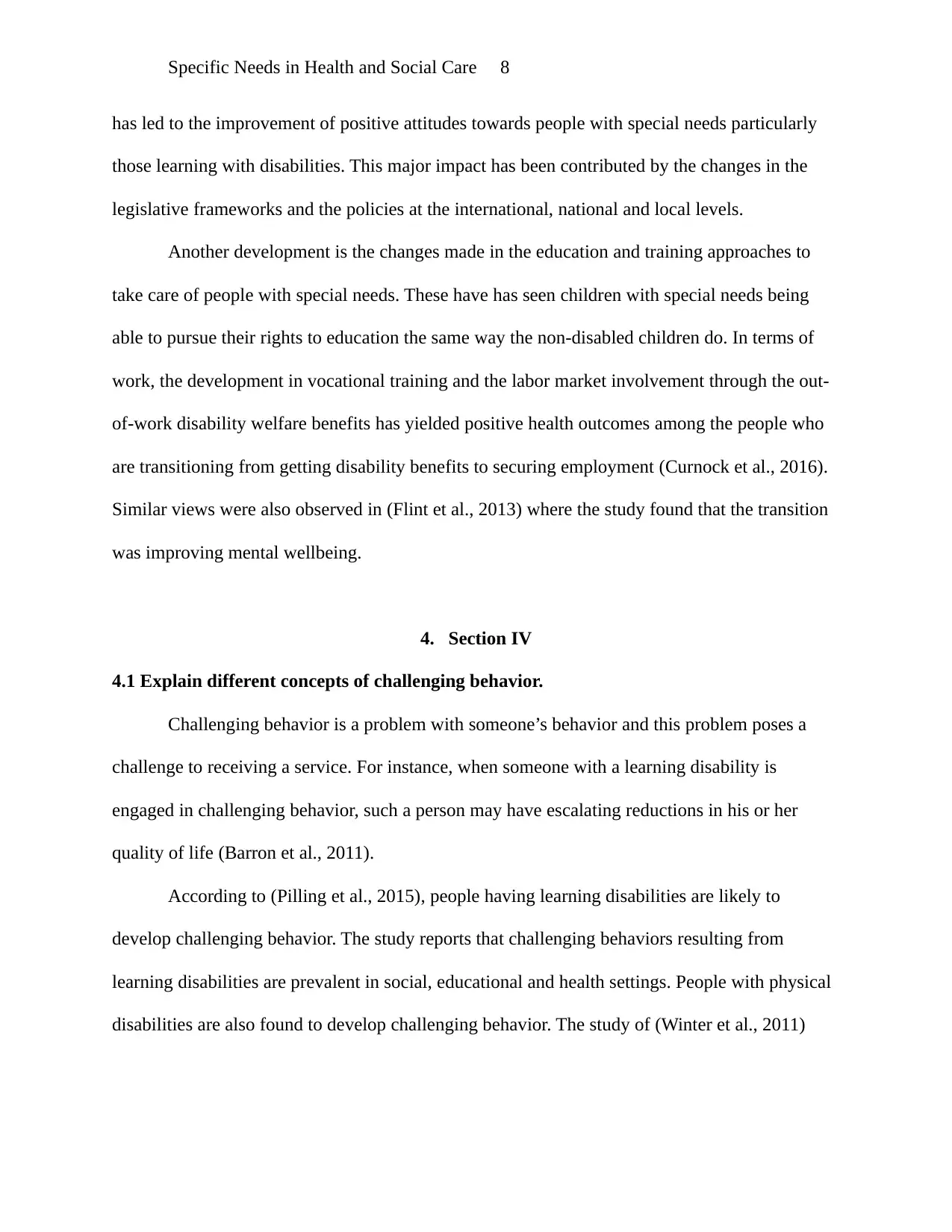
Specific Needs in Health and Social Care 8
has led to the improvement of positive attitudes towards people with special needs particularly
those learning with disabilities. This major impact has been contributed by the changes in the
legislative frameworks and the policies at the international, national and local levels.
Another development is the changes made in the education and training approaches to
take care of people with special needs. These have has seen children with special needs being
able to pursue their rights to education the same way the non-disabled children do. In terms of
work, the development in vocational training and the labor market involvement through the out-
of-work disability welfare benefits has yielded positive health outcomes among the people who
are transitioning from getting disability benefits to securing employment (Curnock et al., 2016).
Similar views were also observed in (Flint et al., 2013) where the study found that the transition
was improving mental wellbeing.
4. Section IV
4.1 Explain different concepts of challenging behavior.
Challenging behavior is a problem with someone’s behavior and this problem poses a
challenge to receiving a service. For instance, when someone with a learning disability is
engaged in challenging behavior, such a person may have escalating reductions in his or her
quality of life (Barron et al., 2011).
According to (Pilling et al., 2015), people having learning disabilities are likely to
develop challenging behavior. The study reports that challenging behaviors resulting from
learning disabilities are prevalent in social, educational and health settings. People with physical
disabilities are also found to develop challenging behavior. The study of (Winter et al., 2011)
has led to the improvement of positive attitudes towards people with special needs particularly
those learning with disabilities. This major impact has been contributed by the changes in the
legislative frameworks and the policies at the international, national and local levels.
Another development is the changes made in the education and training approaches to
take care of people with special needs. These have has seen children with special needs being
able to pursue their rights to education the same way the non-disabled children do. In terms of
work, the development in vocational training and the labor market involvement through the out-
of-work disability welfare benefits has yielded positive health outcomes among the people who
are transitioning from getting disability benefits to securing employment (Curnock et al., 2016).
Similar views were also observed in (Flint et al., 2013) where the study found that the transition
was improving mental wellbeing.
4. Section IV
4.1 Explain different concepts of challenging behavior.
Challenging behavior is a problem with someone’s behavior and this problem poses a
challenge to receiving a service. For instance, when someone with a learning disability is
engaged in challenging behavior, such a person may have escalating reductions in his or her
quality of life (Barron et al., 2011).
According to (Pilling et al., 2015), people having learning disabilities are likely to
develop challenging behavior. The study reports that challenging behaviors resulting from
learning disabilities are prevalent in social, educational and health settings. People with physical
disabilities are also found to develop challenging behavior. The study of (Winter et al., 2011)
⊘ This is a preview!⊘
Do you want full access?
Subscribe today to unlock all pages.

Trusted by 1+ million students worldwide
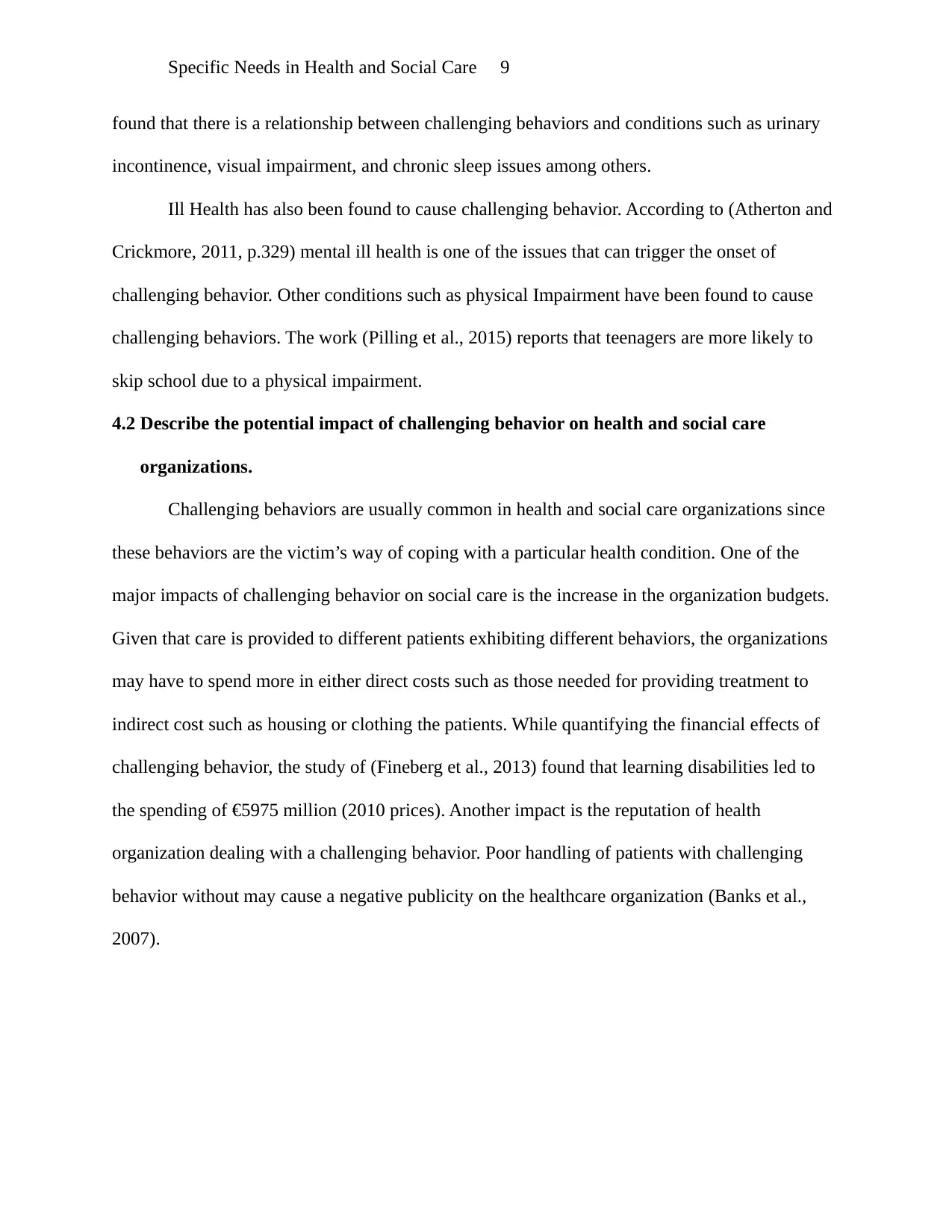
Specific Needs in Health and Social Care 9
found that there is a relationship between challenging behaviors and conditions such as urinary
incontinence, visual impairment, and chronic sleep issues among others.
Ill Health has also been found to cause challenging behavior. According to (Atherton and
Crickmore, 2011, p.329) mental ill health is one of the issues that can trigger the onset of
challenging behavior. Other conditions such as physical Impairment have been found to cause
challenging behaviors. The work (Pilling et al., 2015) reports that teenagers are more likely to
skip school due to a physical impairment.
4.2 Describe the potential impact of challenging behavior on health and social care
organizations.
Challenging behaviors are usually common in health and social care organizations since
these behaviors are the victim’s way of coping with a particular health condition. One of the
major impacts of challenging behavior on social care is the increase in the organization budgets.
Given that care is provided to different patients exhibiting different behaviors, the organizations
may have to spend more in either direct costs such as those needed for providing treatment to
indirect cost such as housing or clothing the patients. While quantifying the financial effects of
challenging behavior, the study of (Fineberg et al., 2013) found that learning disabilities led to
the spending of €5975 million (2010 prices). Another impact is the reputation of health
organization dealing with a challenging behavior. Poor handling of patients with challenging
behavior without may cause a negative publicity on the healthcare organization (Banks et al.,
2007).
found that there is a relationship between challenging behaviors and conditions such as urinary
incontinence, visual impairment, and chronic sleep issues among others.
Ill Health has also been found to cause challenging behavior. According to (Atherton and
Crickmore, 2011, p.329) mental ill health is one of the issues that can trigger the onset of
challenging behavior. Other conditions such as physical Impairment have been found to cause
challenging behaviors. The work (Pilling et al., 2015) reports that teenagers are more likely to
skip school due to a physical impairment.
4.2 Describe the potential impact of challenging behavior on health and social care
organizations.
Challenging behaviors are usually common in health and social care organizations since
these behaviors are the victim’s way of coping with a particular health condition. One of the
major impacts of challenging behavior on social care is the increase in the organization budgets.
Given that care is provided to different patients exhibiting different behaviors, the organizations
may have to spend more in either direct costs such as those needed for providing treatment to
indirect cost such as housing or clothing the patients. While quantifying the financial effects of
challenging behavior, the study of (Fineberg et al., 2013) found that learning disabilities led to
the spending of €5975 million (2010 prices). Another impact is the reputation of health
organization dealing with a challenging behavior. Poor handling of patients with challenging
behavior without may cause a negative publicity on the healthcare organization (Banks et al.,
2007).
Paraphrase This Document
Need a fresh take? Get an instant paraphrase of this document with our AI Paraphraser
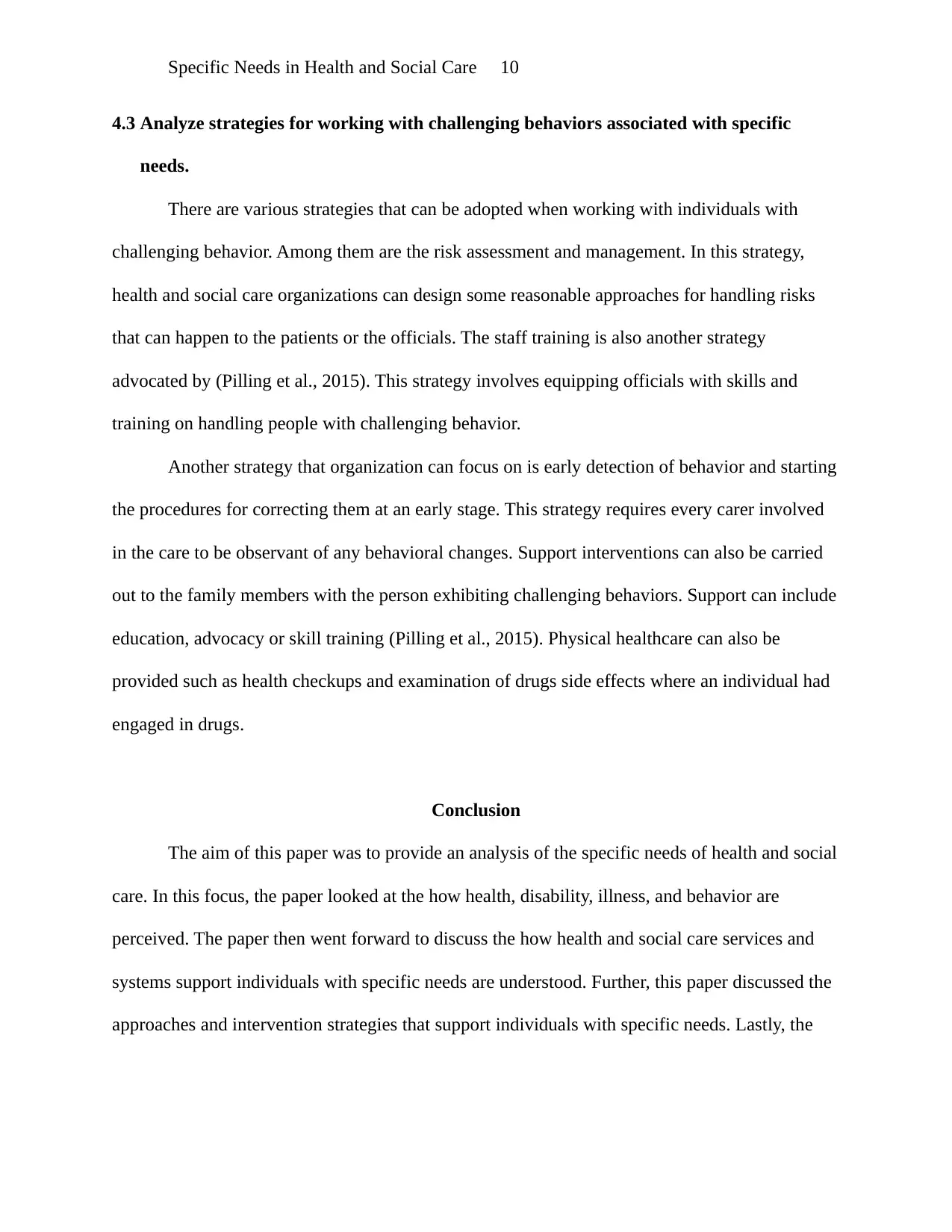
Specific Needs in Health and Social Care 10
4.3 Analyze strategies for working with challenging behaviors associated with specific
needs.
There are various strategies that can be adopted when working with individuals with
challenging behavior. Among them are the risk assessment and management. In this strategy,
health and social care organizations can design some reasonable approaches for handling risks
that can happen to the patients or the officials. The staff training is also another strategy
advocated by (Pilling et al., 2015). This strategy involves equipping officials with skills and
training on handling people with challenging behavior.
Another strategy that organization can focus on is early detection of behavior and starting
the procedures for correcting them at an early stage. This strategy requires every carer involved
in the care to be observant of any behavioral changes. Support interventions can also be carried
out to the family members with the person exhibiting challenging behaviors. Support can include
education, advocacy or skill training (Pilling et al., 2015). Physical healthcare can also be
provided such as health checkups and examination of drugs side effects where an individual had
engaged in drugs.
Conclusion
The aim of this paper was to provide an analysis of the specific needs of health and social
care. In this focus, the paper looked at the how health, disability, illness, and behavior are
perceived. The paper then went forward to discuss the how health and social care services and
systems support individuals with specific needs are understood. Further, this paper discussed the
approaches and intervention strategies that support individuals with specific needs. Lastly, the
4.3 Analyze strategies for working with challenging behaviors associated with specific
needs.
There are various strategies that can be adopted when working with individuals with
challenging behavior. Among them are the risk assessment and management. In this strategy,
health and social care organizations can design some reasonable approaches for handling risks
that can happen to the patients or the officials. The staff training is also another strategy
advocated by (Pilling et al., 2015). This strategy involves equipping officials with skills and
training on handling people with challenging behavior.
Another strategy that organization can focus on is early detection of behavior and starting
the procedures for correcting them at an early stage. This strategy requires every carer involved
in the care to be observant of any behavioral changes. Support interventions can also be carried
out to the family members with the person exhibiting challenging behaviors. Support can include
education, advocacy or skill training (Pilling et al., 2015). Physical healthcare can also be
provided such as health checkups and examination of drugs side effects where an individual had
engaged in drugs.
Conclusion
The aim of this paper was to provide an analysis of the specific needs of health and social
care. In this focus, the paper looked at the how health, disability, illness, and behavior are
perceived. The paper then went forward to discuss the how health and social care services and
systems support individuals with specific needs are understood. Further, this paper discussed the
approaches and intervention strategies that support individuals with specific needs. Lastly, the

Specific Needs in Health and Social Care 11
paper discussed the strategies for coping with challenging behaviors that are experienced by
people with specific needs.
paper discussed the strategies for coping with challenging behaviors that are experienced by
people with specific needs.
⊘ This is a preview!⊘
Do you want full access?
Subscribe today to unlock all pages.

Trusted by 1+ million students worldwide
1 out of 14
Related Documents
Your All-in-One AI-Powered Toolkit for Academic Success.
+13062052269
info@desklib.com
Available 24*7 on WhatsApp / Email
![[object Object]](/_next/static/media/star-bottom.7253800d.svg)
Unlock your academic potential
Copyright © 2020–2025 A2Z Services. All Rights Reserved. Developed and managed by ZUCOL.


